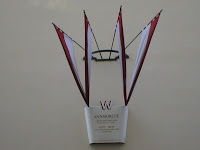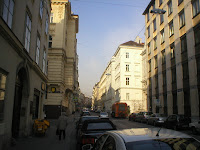
PART II - IN THE FOOTSTEPS OF ST. CLEMENT IN VIENNA
SEVENTH STOP:
CHURCH AND CONVENT OF ST. URSULA
(KIRCHE UND KLOSTER ST. URSULA)
Along Johannesgasse and Seilerstatte
Again, a historical marker indicating this building's historical importance.
 The building that once housed the convent of St. Ursula now serves as classrooms for the Music University. The church has been preserved but it is mainly used now for concerts and student recitals. One has to seek the permission of the porter of the Department of Church Music to be allowed entrance to the church. (I did manage to enter the church because there was a recital and the photos I took are in the latter part of this presentation).
The building that once housed the convent of St. Ursula now serves as classrooms for the Music University. The church has been preserved but it is mainly used now for concerts and student recitals. One has to seek the permission of the porter of the Department of Church Music to be allowed entrance to the church. (I did manage to enter the church because there was a recital and the photos I took are in the latter part of this presentation).This is the entrance to the Music University today.


The building that housed both the church and the convent of St. Ursula as seen from the front near a road intersection.
THE IRON PEAR BAKERY (BACKEREI ZUR EISERNEN BIRNE)
Along Johannesgasse and Seilerstatte
Opposite the building that housed the church and convent of St. Ursula is the building where St. Clement worked as a journeyman for Master Baker Weyring who might have leased the place from Sebastian Stadt who later became his son-in-law.

These two doors today lead to apartments in this building. Here St. Clement sought shelter during the fierce bombardment of Vienna by the Napoleonic artillery on 11-12 May 1809.

These two doors today lead to apartments in this building. Here St. Clement sought shelter during the fierce bombardment of Vienna by the Napoleonic artillery on 11-12 May 1809.
APARTMENT HOUSE OF THE URSULINES
(WOHNHAUS DER URSULINEN)
Along Seilerstatte and Fichtegasse
On this site was a building where the Ursulines owned an apartment house, which is quite near their convent. It was then a three-storey apartment which was quite old and neglected. St. Clement moved here on 18 July 1813.

(Backtrack to the building that housed the convent and church of St. Ursula):

(Backtrack to the building that housed the convent and church of St. Ursula):
Today there is a plaque on the wall of this building. This plaque commemorates the last station of St. Clement's pastoral ministries. This plaque was unveiled on 18 September 1910 and is the work of the sculptor Franz Seifert.

The plaque as seen at the top level of a wall of the building.

Another view of the plaque which can be seen by the side of the window (rightmost) of the first floor.

Again a historical marker on this building.

The plaque as seen just below where it was attached.

This is part of the building that once was the site of the apartment house of the Ursulines where St. Clement lived for a while. Today it houses the embassy of Albania and the EU office of Romania as can be seen in the fluttering flags.

On the ground floor of this building is a Mediterranean and Asian restaurant.

In the three-storey apartment which stood here once before this building was constructed was where St. Clement lived. He also died here on 15 March 1820.
The apartment had a large room that served as reception room, study, dining room and bedroom. But it was also the chapel and used for pastoral counselling. Sometimes it was also the assembly room of a number of personalities connected to the Romantic School. Young people also came to meet St. Clement here as he attracted them like a magnet.
(ST. ANNA-KRICHE AND NORMALSCHULE)
Along Annagasse
In this place, St. Clement and his friend Hubl attended a course after they were professed and ordained to the priesthood. The course included lectures in pedagogy and catechetics as well as practical exercises.

A kind of a teacher training school was also established here by Empress Maria Theresa. This building served various purposes through the years: as convent of the Poor Clares and the Jesuits, then as art school, an exhibition hall and as school. Today it is a monastery of the Oblates of St. Francis de Sales.

To have an understanding of how Vienna developed into an important site of the rise of the Romantic School, I had an exposure to its museums, art galleires, public monuments and the like, as well as what constitutes the magic of this city.
I visited its old and modern art museums and enjoyed the paintings of Gustav Klimt and Ego Schille.


The old imperial buildings that go back to the Emperors of old.









Some of the archaeological ruins dugged up show that the Romans built infrastructure in this city as early as the 5th century.
 (BACK TO THE CHURCH OF ST. URSULA)
(BACK TO THE CHURCH OF ST. URSULA)This is the interior of the church of St. Ursula where there are many items that connect to St. Clement. A side altar shows St. Clement in front of Our Lady and in the background there is a romatic view of Vienna from the first half of the 19th century.

A close-up photo of the painting.

This is the pulpit that St. Clement used to preach his famous sermons.


The main altar of the church.

The pipe organ which is still being used by the students.

To the left of this photo one can see the Pieta. Earlier, here on this spot was a confessional used by St. Clement which has been transferred to Maria am Gestade church.
The people here came for a
students' recital.

A side altar in the church.

Close-up of the painting with St. Clement and Mary with child.

The letters are on the ceiling of the roof of the pulpit.

 ELEVENTH STOP:
ELEVENTH STOP:MECHITARIST CHURCH AND MONASTERY
(MECHITARISTENKIRCHE U KLOSTER)
Mechitaristengasse and Ecke Neustiftgasse
This church and monastery belong to the Mechitarists, an Armenian-Catholic Order founded in Constantinople in 1701. They came to Vienna in 1810 in search of asylum after the Napoleonic wars. On this site the Capuchins built a monastery in 1600 which was burned down in 1835 but rebuilt in 1837. the present church was built from 1871 to 1874. The church is located a little far from the center of Vienna.
This church and monastery belong to the Mechitarists, an Armenian-Catholic Order founded in Constantinople in 1701. They came to Vienna in 1810 in search of asylum after the Napoleonic wars. On this site the Capuchins built a monastery in 1600 which was burned down in 1835 but rebuilt in 1837. the present church was built from 1871 to 1874. The church is located a little far from the center of Vienna.

I could not enter the church as it was not the time for services. I could only see the inside through a glass door. St. Clement came to visit the Mechitarists as he thought of them highly. He also came to pray in this church in front of a painting - Maria Rosa Mystica (Our Lady shows her child a rose).












No comments:
Post a Comment